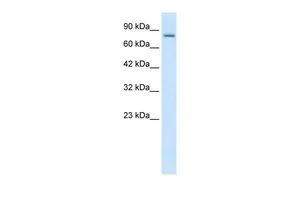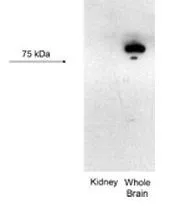
IHC-P analysis of Rhesus macaque spinal cord tissue using GTX47693 KCNN3 antibody at 1:300.
KCNN3 antibody, C-term
GTX47693
ApplicationsWestern Blot, ImmunoHistoChemistry, ImmunoHistoChemistry Paraffin
Product group Antibodies
ReactivityHuman, Monkey, Mouse
TargetKCNN3
Overview
- SupplierGeneTex
- Product NameKCNN3 antibody, C-term
- Delivery Days Customer9
- Application Supplier NoteWB: 0.2-2.5 ug/ml. IHC-P: 2-10 ug/ml. *Optimal dilutions/concentrations should be determined by the researcher.Not tested in other applications.
- ApplicationsWestern Blot, ImmunoHistoChemistry, ImmunoHistoChemistry Paraffin
- CertificationResearch Use Only
- ClonalityPolyclonal
- Concentration0.5-1 mg/ml
- ConjugateUnconjugated
- Gene ID3782
- Target nameKCNN3
- Target descriptionpotassium calcium-activated channel subfamily N member 3
- Target synonymshSK3; KCa2.3; potassium channel, calcium activated intermediate/small conductance subfamily N alpha, member 3; potassium intermediate/small conductance calcium-activated channel, subfamily N, member 3; SK3; SKCa 3; SKCA3; small conductance calcium-activated potassium channel 3; small conductance calcium-activated potassium channel protein 3; ZLS3
- HostRabbit
- IsotypeIgG
- Protein IDQ9UGI6
- Protein NameSmall conductance calcium-activated potassium channel protein 3
- Scientific DescriptionAction potentials in vertebrate neurons are followed by an afterhyperpolarization (AHP) that may persist for several seconds and may have profound consequences for the firing pattern of the neuron. Each component of the AHP is kinetically distinct and is mediated by different calcium-activated potassium channels. This gene belongs to the KCNN family of potassium channels. It encodes an integral membrane protein that forms a voltage-independent calcium-activated channel, which is thought to regulate neuronal excitability by contributing to the slow component of synaptic AHP. This gene contains two CAG repeat regions in the coding sequence. It was thought that expansion of one or both of these repeats could lead to an increased susceptibility to schizophrenia or bipolar disorder, but studies indicate that this is probably not the case. Alternatively spliced transcript variants encoding different isoforms have been found for this gene. [provided by RefSeq, Feb 2011]
- ReactivityHuman, Monkey, Mouse
- Storage Instruction-20°C or -80°C,2°C to 8°C
- UNSPSC12352203
References
- Homocysteine alters vasoreactivity of human internal mammary artery by affecting the K(Ca) channel family. Sun WT et al., 2021 Apr, Ann Transl MedRead more



